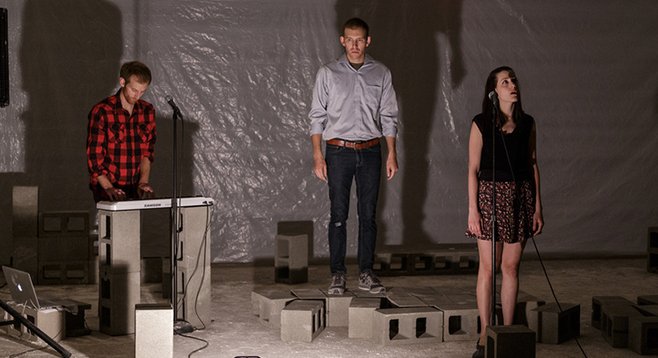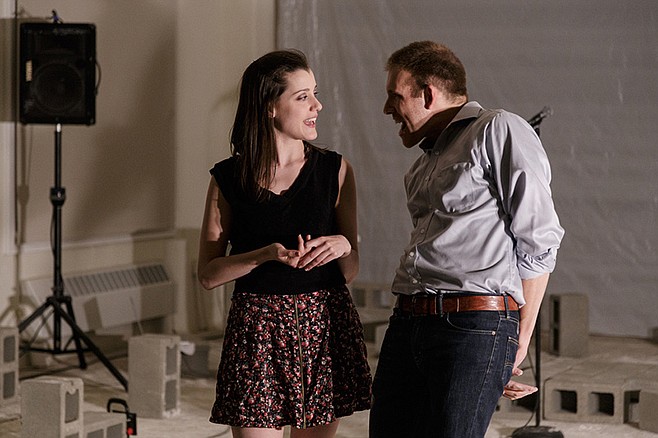 Facebook
Facebook
 X
X
 Instagram
Instagram
 TikTok
TikTok
 Youtube
Youtube

Last Call: Tom Dugdale and the Trip’s world premiere must close this weekend. This inventive, intriguing, multi-leveled show is a definite must-see.
The stage, part of a barracks at Liberty Station, looks strange. Rectangular cinder blocks lie in random clusters on a floor as white as the surrounding walls.
As the play takes us on a tour, the floor’s white chalk clings to the costumes and leaves traces of previous scenes. And the blocks are what remains of Taylor, Tom, and Thomas’ family home. Not long ago, it burned down. One of the questions the play asks – who torched the house?
Taylor and Thomas were a thousand miles away. Or were they? And Tom?

They meet after 12 years apart and, as we come to know them and their dysfunctional family, each could be a suspect.
But that mystery gives way to deeper ones, about memory, and unbound ties, and life’s labyrinths, and even about the script, as when Taylor asks “what the hell is this play?”
Well for starters, it’s a mixed-genre, non-linear exploration of the family, the house, and the resources of the stage.
Scenes, which often open with a flash, surprise: hugely funny variations on how their parents, Bob and Maggie, met (in one, Bob says, “I’m the Torpedo Man just back from a terrible war”; in another Maggie somehow catches his eye while wearing a blood-strewn butcher’s apron); a haunting Christmas ballet; a violent confrontation between Bob and Maggie in silhouette; a swimming pool sequence; a literal reconstruction to the beat of thunking blocks.
Scenes unfold like fragments. They appear disjointed, but maybe by design. They support the trio’s fractured view of the past, and their need to make sense of themselves as errant parts without a whole.
All the while understanding that “a work is never finished.”
All the Rooms of the House is also the biography of a place. The house had been a lean-to, a church, a barracks, a hospital, a brothel. The accumulation that suggests a history of more than just the charred building.
Another level: the actors have the same names as their characters — Tom (Dugdale), Taylor (Shurte), and Thomas (Miller). So there’s a sense that, throughout their committed performances, there’s a doubly-personal quality. The recollections of the trio may jibe with deeply painful memories of the cast.
The piece, if such a thing is imaginable, is a sprightly geological dig. And a musical: Tom Dugdale’s original score ranging from solemn to hip and hilarious. Rooms is funny and moving and so informal that the unfussy scene shifts (screw in a bulb, re-focus a lens, change costumes) happen before your eyes; just preparing for what’s next.
Mountains of performance theory stand behind their relaxed, open approach to an audience (among them, Jacques Ranciere’s The Emancipated Spectator). But you never see pages or print. Instead you feel an amazing rapport.


Last Call: Tom Dugdale and the Trip’s world premiere must close this weekend. This inventive, intriguing, multi-leveled show is a definite must-see.
The stage, part of a barracks at Liberty Station, looks strange. Rectangular cinder blocks lie in random clusters on a floor as white as the surrounding walls.
As the play takes us on a tour, the floor’s white chalk clings to the costumes and leaves traces of previous scenes. And the blocks are what remains of Taylor, Tom, and Thomas’ family home. Not long ago, it burned down. One of the questions the play asks – who torched the house?
Taylor and Thomas were a thousand miles away. Or were they? And Tom?

They meet after 12 years apart and, as we come to know them and their dysfunctional family, each could be a suspect.
But that mystery gives way to deeper ones, about memory, and unbound ties, and life’s labyrinths, and even about the script, as when Taylor asks “what the hell is this play?”
Well for starters, it’s a mixed-genre, non-linear exploration of the family, the house, and the resources of the stage.
Scenes, which often open with a flash, surprise: hugely funny variations on how their parents, Bob and Maggie, met (in one, Bob says, “I’m the Torpedo Man just back from a terrible war”; in another Maggie somehow catches his eye while wearing a blood-strewn butcher’s apron); a haunting Christmas ballet; a violent confrontation between Bob and Maggie in silhouette; a swimming pool sequence; a literal reconstruction to the beat of thunking blocks.
Scenes unfold like fragments. They appear disjointed, but maybe by design. They support the trio’s fractured view of the past, and their need to make sense of themselves as errant parts without a whole.
All the while understanding that “a work is never finished.”
All the Rooms of the House is also the biography of a place. The house had been a lean-to, a church, a barracks, a hospital, a brothel. The accumulation that suggests a history of more than just the charred building.
Another level: the actors have the same names as their characters — Tom (Dugdale), Taylor (Shurte), and Thomas (Miller). So there’s a sense that, throughout their committed performances, there’s a doubly-personal quality. The recollections of the trio may jibe with deeply painful memories of the cast.
The piece, if such a thing is imaginable, is a sprightly geological dig. And a musical: Tom Dugdale’s original score ranging from solemn to hip and hilarious. Rooms is funny and moving and so informal that the unfussy scene shifts (screw in a bulb, re-focus a lens, change costumes) happen before your eyes; just preparing for what’s next.
Mountains of performance theory stand behind their relaxed, open approach to an audience (among them, Jacques Ranciere’s The Emancipated Spectator). But you never see pages or print. Instead you feel an amazing rapport.
Comments